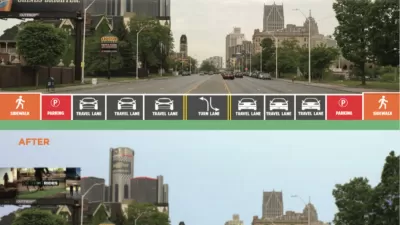San Diego's Draft Downtown Mobility Plan is laudable but consists of basic generalities and vanilla concepts, ignoring how an urban environment functions, writes Jimmy Parker, former president of the city's most urban business district.
The city of San Diego recently released its long-anticipated Draft Downtown Mobility Plan for comment. The plan, based on a complete streets concept, is long on generalities and suburban notions of urban tranquility but short on a detailed and practical understanding of the workings of an urban environment, writes Jimmy Parker, former Gaslamp Quarter business improvement district (BID) president and urban consultant. Parker acknowledges:
The plan clearly illustrates that they listened to the cycling community in San Diego and incorporated cycling safety ideas from around the country. They are championing more green in our urban street diet, consistent with the downtown community plan and the desire of many groups interested in downtown.
So what's wrong with the plan? Parker writes:
We all too often attempt to recreate what we value in our suburban neighborhoods without the understanding of what it takes establish and sustain these ideas, designs and initiatives in a dynamic urban setting.
For one, the plan's drafters fail to address how the proposed widened sidewalks operate, inter-relate with their adjacent uses, and need to be maintained, writes Parker. Parker also criticizes the plan for continuing to focus on traffic flow (including dedicated bicycle lanes) rather than creating a calmer and more cohesive urban environment.
Parker has several specific criticisms and recommendations borne of decades of hands-on management of the San Diego's downtown historic district and dining and entertainment destination, the Gaslamp Quarter.
FULL STORY: Downtown San Diego Mobility Plan – Vision for the Future or A Well Intentioned Waste of Money?

Alabama: Trump Terminates Settlements for Black Communities Harmed By Raw Sewage
Trump deemed the landmark civil rights agreement “illegal DEI and environmental justice policy.”

Study: Maui’s Plan to Convert Vacation Rentals to Long-Term Housing Could Cause Nearly $1 Billion Economic Loss
The plan would reduce visitor accommodation by 25% resulting in 1,900 jobs lost.

Why Should We Subsidize Public Transportation?
Many public transit agencies face financial stress due to rising costs, declining fare revenue, and declining subsidies. Transit advocates must provide a strong business case for increasing public transit funding.

Wind Energy on the Rise Despite Federal Policy Reversal
The Trump administration is revoking federal support for renewable energy, but demand for new projects continues unabated.

Passengers Flock to Caltrain After Electrification
The new electric trains are running faster and more reliably, leading to strong ridership growth on the Bay Area rail system.

Texas Churches Rally Behind ‘Yes in God’s Back Yard’ Legislation
Religious leaders want the state to reduce zoning regulations to streamline leasing church-owned land to housing developers.
Urban Design for Planners 1: Software Tools
This six-course series explores essential urban design concepts using open source software and equips planners with the tools they need to participate fully in the urban design process.
Planning for Universal Design
Learn the tools for implementing Universal Design in planning regulations.
Caltrans
Smith Gee Studio
Institute for Housing and Urban Development Studies (IHS)
City of Grandview
Harvard GSD Executive Education
Toledo-Lucas County Plan Commissions
Salt Lake City
NYU Wagner Graduate School of Public Service



























